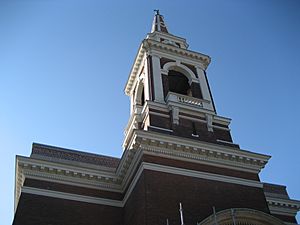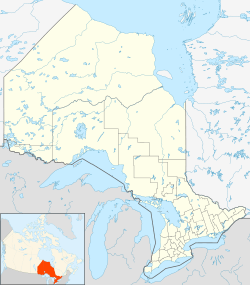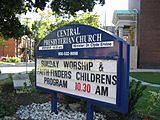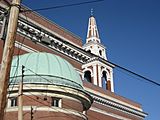Central Presbyterian Church (Hamilton, Ontario) facts for kids
Quick facts for kids Central Presbyterian Church |
|
|---|---|

Church spire
|
|
| 43°15′04″N 79°52′45″W / 43.25111°N 79.87917°W | |
| Location | 165 Charlton Avenue West Hamilton, Ontario L8P 2C8 |
| Country | Canada |
| Denomination | Presbyterian Church in Canada |
| History | |
| Founded | 1841 |
| Specifications | |
| Number of spires | 1 |
| Administration | |
| Presbytery | Hamilton |
| Synod | Southwestern Ontario |
Central Presbyterian Church is a church in Hamilton, Ontario, Canada. It belongs to the Presbyterian Church in Canada. You can find it in the downtown area, at 165 Charlton Avenue West, right where Charlton and Caroline Street South meet.
Contents
A Look Back: The Church's History
How the Church Started
The church community began in 1841. It was part of the United Presbyterian Church of Scotland's group in Canada. Before that, starting in 1837, a missionary named Thomas Christie visited them monthly. He came from nearby West Flamboro to help set up churches in the area.
The first meetings were held in an old schoolhouse in downtown Hamilton. There were already two bigger Presbyterian churches nearby. One was St Andrew's, now called St. Paul's. The other was MacNab Street Presbyterian Church (Hamilton).
Rebuilding and New Beginnings
In 1858, the church building was rebuilt. After a big church merger in 1875, it became known as Central Presbyterian Church. Their former pastor, William Ormiston, helped start the idea for this merger. He moved to New York City in 1870.
On June 21, 1906, a huge fire destroyed the 1858 building. Plans quickly started to build a new church in a different spot. The minister's son, John M. Lyle, was the architect for this new building.
The New Church Building
The new church opened on June 14, 1908. It included a large Casavant Frères pipe organ. John M. Lyle designed many famous buildings. These include Toronto's Royal Alexandra Theatre and Union Station (Toronto). He also designed the Runnymede branch of the Toronto Public Library. Central Presbyterian Church is the only church building Lyle ever designed.
Lyle's design for the church was inspired by other famous buildings. These included the Church of St. Martin-in-the-Fields in London. It also looked like the Congregational Church of Naugatuck, Connecticut. The church has a flat roof, which was unusual for churches at the time. It looked more like public buildings designed by the École des Beaux-Arts.
Inside the church, you can see beautiful stained-glass windows. They show stories from the Bible. The church's tall spire lights up at night. It is a well-known landmark you can see from many parts of Hamilton. You can even see it from the top of the nearby Niagara Escarpment.
Staying Presbyterian
In 1925, there was a vote about whether the church should join the United Church of Canada. The members voted very closely, 398 to 381, to stay with the Presbyterian Church in Canada. Because of this, the minister, Rev. William Sedgewick, and many members left to join the United Church of Canada.
Important People from Central Church
Two members of Central Church became very important leaders. They were appointed to represent the King as Lieutenant Governor of Ontario. This is a high-ranking position in the government of Ontario.
- Sir John Morison Gibson served from 1908 to 1914.
- Sir John Strathearn Hendrie served from 1914 to 1919.
There are special plaques inside the church to remember these two leaders. Even today, members of Central Church are involved in Hamilton's public life. They work in city government, the arts, and education. They also play important roles within the Presbyterian Church in Canada.
Central Church Today
The church is still very active in downtown Hamilton. It was known for its music programs for a long time. It also has a special connection with The Argyll and Sutherland Highlanders, a Canadian army regiment. The church is also known for having ministers who stay for many years. The current minister is the Rev. Dr. Gregory Davidson. He started his role in August 2015.
Image gallery





